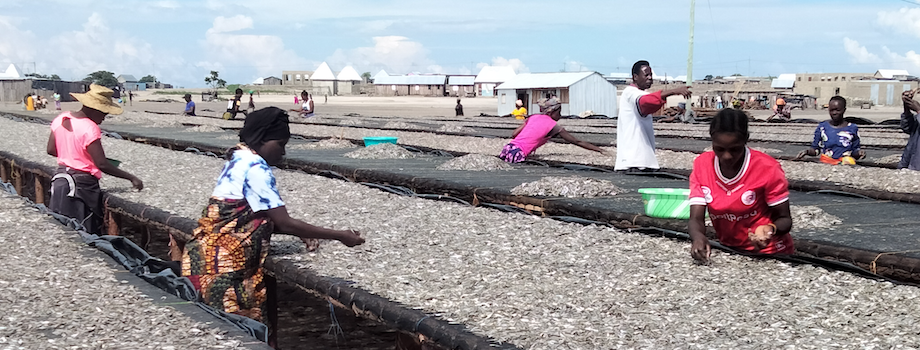Revitalizing the Retail of Fresh Fish Dagaa in Tanzania: A Gateway to Nutritional Security and Economic Empowerment
By Joseph Luomba, FAO
In the bustling markets of Tanzania, amidst the vibrant colours and bustling crowds, a humble yet essential commodity takes centre stage: fresh fish dagaa, or small pelagic fish. These tiny silver fish, often overlooked by many, play a crucial role in the diet of millions of Tanzanians and hold significant economic potential for coastal communities.
The retail of fresh dagaa in Tanzania involves a diverse array of stakeholders, including small-scale fishers, traders, processors, and consumers. Small-scale fishers, often operating traditional fishing vessels, brave the waters to harvest fresh dagaa using artisanal fishing gear such as gillnets and cast nets. Traders play a pivotal role in transporting the freshly caught dagaa from fishing communities to urban markets, where they are sold to consumers. Processors, although fewer in number, contribute to value addition by processing and packaging dagaa products for domestic consumption and export.
However, despite their nutritional and economic importance, the retail of fresh fish dagaa faces numerous challenges, from post-harvest losses to market access barriers. It is estimated that about 22 percent of dagaa experiences physical as well as quality loss at production level. Other actors have physical and quality losses of about 10 percent (TAFIRI, 2023). In this article, we explore the significance of fresh fish dagaa in Tanzania, the challenges hindering its retail, and potential strategies for revitalizing this vital sector.
The Significance of Fresh Fish Dagaa
Fresh fish dagaa, primarily harvested from Lake Victoria, Lake Tanganyika, and the Indian Ocean, are a rich source of protein, omega-3 fatty acids, and essential micronutrients. In a country where malnutrition remains a pressing concern, especially among children and pregnant women, fresh fish dagaa offer a nutritious and affordable food option. Moreover, they play a crucial role in supporting the livelihoods of small-scale fishers and traders, providing them with a source of income and economic stability.
Challenges Facing the Retail of Fresh Fish Dagaa
Despite its economic and nutritional importance, the retail of fresh dagaa in Tanzania is plagued by challenges related to fish loss and waste. Post-harvest losses occur at various stages of the value chain, from improper handling and storage practices to transportation delays and spoilage. Inadequate infrastructure, including cold storage facilities and transportation networks, exacerbates these losses, leading to significant economic and nutritional losses. Moreover, fish waste, including discarded bycatch and unsold fish, further compounds the problem, contributing to environmental pollution and resource depletion:
- Post-Harvest Losses: Poor handling practices and inadequate storage facilities contribute to significant post-harvest losses, reducing the quality and quantity of fish available for retail.
- Infrastructure Deficiencies: Limited access to reliable transportation, storage, and processing facilities hampers the efficient distribution of fresh fish dagaa from fishing communities to urban markets.
- Market Access Barriers: Small-scale fishers and traders often face barriers to accessing formal markets, including high transaction costs, complex regulatory requirements, and limited market information.
- Seasonal Variability: Fluctuations in fish availability and catch volumes, driven by seasonal changes and environmental factors, pose challenges for maintaining a consistent supply of fresh fish dagaa throughout the year.
Strategies for Revitalizing the Retail of Fresh Fish Dagaa
Addressing the challenges facing the retail of fresh fish dagaa requires a multi-faceted approach, involving collaboration between government agencies, civil society organizations, and private sector stakeholders. In addition, the strategies need to address the challenges through a multi-dimensional approach that focuses on the key issues affecting the fisheries. These include:
- Regulatory Reform: Streamline regulatory processes and reduce bureaucratic hurdles for small-scale fishers and traders, making it easier for them to comply with legal requirements and access formal markets.
- Investment in Infrastructure: Prioritize investments in transportation, storage, processing, finances and services and market infrastructure to improve the efficiency of fish distribution networks and reduce post-harvest losses.
- Capacity Building: Provide training and technical assistance to small-scale fishers and traders on best practices for fish handling, storage, entrepreneurship and marketing to enhance their competitiveness and resilience.
- Market Diversification: Explore opportunities for diversifying products, value additions, market channels, including local markets, supermarkets, restaurants, and export markets, to expand the consumer base for fresh fish dagaa.
- Promotion of Sustainable Fisheries Practices: Encourage sustainable fishing practices and conservation efforts to ensure the long-term viability of fish stocks and ecosystems, safeguarding the future of fresh fish dagaa.
Fresh fish dagaa are more than just a commodity; they are a cornerstone of Tanzanian that represents a critical nexus of economic opportunity, nutrition, and cultural heritage. However, the sector faces formidable challenges, including fish loss and waste, which undermine its sustainability and potential. By adopting a multi-dimensional approach covering issues of policies, markets, infrastructure, technology, capacity building, social and gender, Tanzania can unlock the full potential of its fresh dagaa retail sector thus ensuring its continued prosperity and resilience for generations. In addition, a multi-stakeholder approach involving government intervention, private sector investment, and community participation.

